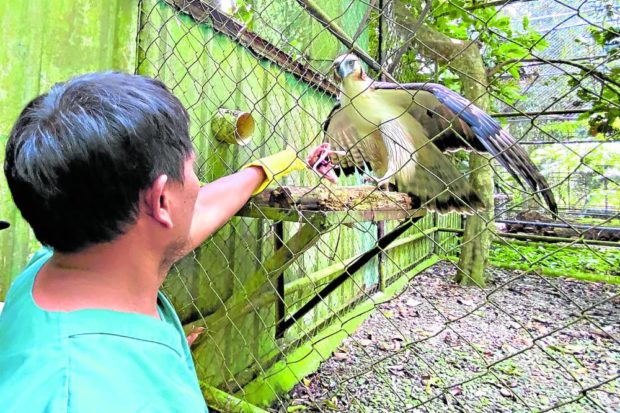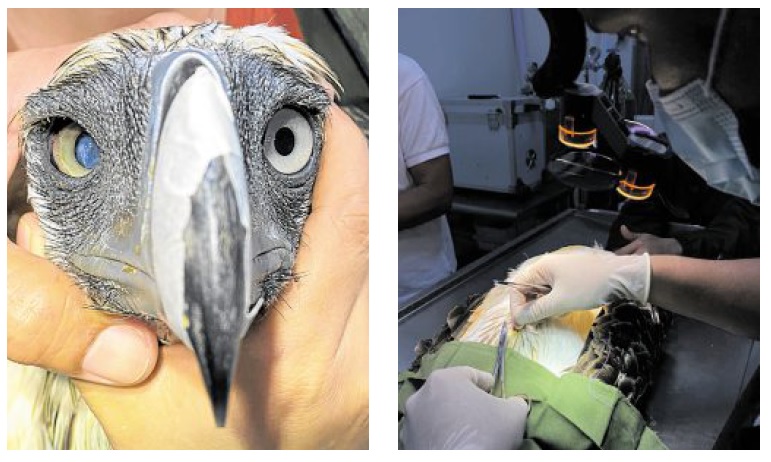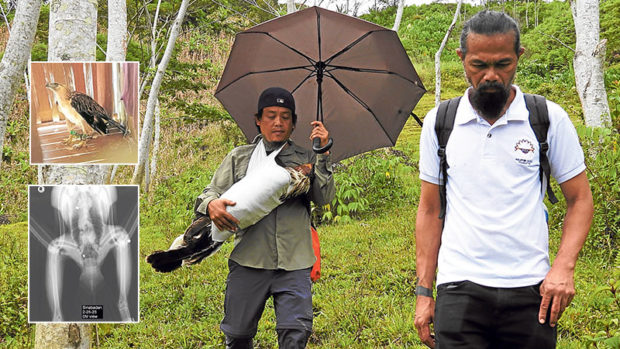PH eagle tracked in study shot, wounded by poachers

FEEDING TIME A staff member of the Philippine Eagle Center at Malagos district in Davao City feeds an endangered Philippine eagle under its care. The conservation center has become the refuge
of endangered birds rescued from poachers, like the injured Sinabadan, who was found in the forests of San Fernando, Bukidnon. —ERWIN M.MASCARIÑAS
CAGAYAN DE ORO CITY—Sinabadan, a female Philippine eagle (Pithecophaga jefferyi) whose well-tracked life provided conservationists deeper knowledge on the growth and maturation of the endangered raptor in the wild, is recuperating at the Philippine Eagle Center in Davao City after surviving a poacher’s attack in Bukidnon province five days ago.
The country’s national symbol, the Philippine eagle, is one of the rarest eagles in the world, and one of the largest and most powerful birds of prey.
The International Union for Conservation of Nature classifies it as critically endangered as only 400 pairs of the bird remain in the wild, thriving in the dwindling forests of Luzon, Samar, Leyte and Mindanao.
Community-based forest guards trained by the Philippine Eagle Foundation (PEF) found Sinabadan near a creek in San Fernando town, Bukidnon, on Feb. 24. She was too weak to even resist being taken by rescuers, and also showed signs of dehydration.
PEF experts told the Inquirer Sinabadan was malnourished and underweight. During an X-ray exam, PEF veterinarians found three air-gun pellets in her body—one in the chest, another in the thigh, and still another deep in the abdomen. Those in the chest and thigh were removed during surgery on Saturday.
The pellet wound in Sinabadan’s chest was still fresh, while the two others were probably inflicted a few months ago, said Dr. Jayson Ibañez, the PEF director for research and conservation.
Due to her injuries, PEF experts worry Sinabadan may not be able to live in the wild again, and put an abrupt end to a budding love affair with another raptor.
“This is heartbreaking and painful for all of us in the PEF. We are extremely appalled by this incident, we condemn such acts of violence against the world’s rarest eagle,” said Ibañez, who has been acknowledged as some kind of surrogate parent to the raptor, having monitored her since she was about a year old.
Sinabadan was also found to have poor vision due to a cataract buildup in her right eye which, Ibañez said, might have affected her hunt for prey and resulted in her malnutrition. Her condition was aggravated by the poacher’s attack, he lamented.
Unsafe
“Many of our forests still remain unsafe for our national bird,” Ibañez noted, pointing to some 10 raptors who survived gun attacks by poachers during the pandemic, many of them lost the capacity to live in the wild again.
Dennis Salvador, the PEF executive director, said the shooting of Sinabadan “is tragic and shows the need for the government to do more” to address the threats against the country’s wildlife.
“Shooting and hunting continue to plague the plight of the species in the wild. If we keep losing young birds, there will be none left to replace old breeding populations,” Salvador said.
“We are hoping that our government can begin investing in enforcing our laws and putting an end to hunting and trapping of critically endangered species in the wild, not only for our Philippine eagle but for all other species,” he added.

HEALTH ISSUES The right eye of Philippine eagle Sinabadan indicates a cataract has clouded her vision but veterinarians say she is not fully blind. At right, veterinarian Bayani Vandenbroeck operated on and removes the air-gun pellet from the chest of Sinabadan after she was taken to the Philippine Eagle Center in Davao City. —PHOTOS COURTESY OF PHILIPPINE EAGLE FOUNDATION
“We don’t know others are getting extinct, if this can happen to Sinabadan who we have closely monitored for years, what else for other species out there in the wild?” Salvador said.
Then living in the vicinity of Mt. Apo, Sinabadan lost her father to a hunter’s gun in 2014 while she was still a 7-month-old chick. Eaglets normally rely heavily on their male parents to bring them food, which had conservationists worry back then that Sinabadan might not survive long.
Reared by single parent
“But amazingly, the mother fought hard for Sinabadan to live,” Ibañez recalled.
This is why the PEF considers Sinabadan as the world’s first juvenile eagle reared successfully to independence in the wild by a single eagle parent.
By then, Sinabadan—named after a Bagobo Tagabawa people’s organization whose members guarded her natural habitat—was strapped with radio and GPS transmitters to allow conservationists to monitor her every movement.
Ibañez said that Sinabadan left Mt. Apo for good in November 2017.
“It was a remarkable and challenging journey getting to the next big forest, and flying over peopled landscapes, given that Mindanao’s forest cover now are mostly fragments in a sea of farmlands, orchards and open areas,” he said.
“Remarkably, Sinabadan used small patches of forests as her cover and pit stops. From a naive juvenile, she had grown wary through time. She dispersed secretly and gradually, covering distances of no more than 2 kilometers daily,” Ibañez said of the bird’s journey.

DELICATE RESCUE A wounded Philippine eagle named Sinabadan is carried by Philippine Eagle Foundation field biologist Rowell Ron Lemente Taraya, accompanied by senior animal keeper Dominic Tadena, after the endangered raptor is rescued in the forests of San Fernando in Bukidnon province last week. The bird could still stand but was weak and dehydrated (upper inset) and an X-ray taken later showed air-gun pellets lodged in its body. —PHOTOS COURTESY OF THE PHILIPPINE EAGLE FOUNDATION
“She also followed riverine forests, such as those along Davao and Pulangi rivers. At Pulangi, PEF biologists saw her chase monkeys. Flying lemurs, palm civets, hornbills and other food animals were also recorded at forests where Sinabadan temporarily took shelter. These data on how a juvenile eagle used and flew across a bigger, human-dominated terrain were all new to science,” Ibañez said.
A July 2020 PEF report showed Sinabadan was 80 km away from where she was born, recording a total of 47,459 GPS locations over six years of remote monitoring from a total of four GPS transmitters strapped on her back. This meant the PEF team had to trap Sinabadan three more times to replace units that expired.
Now sexually mature, Sinabadan has been observed doing courtship displays, which means she is at an “early pairing stage.” Philippine eagles normally take time to pair. INQ